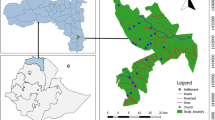Abstract
Presented are the results from investigating carbon balance in forests of the transboundary Selenga river basin, based on inventory data for the status of forest reserves and he key factors (tree felling and forest fires) influencing carbon absorption and emission in forests. Analysis of the forest reserves in the Buryat and Mongolian parts of the Selenga river basin revealed distinctive features in the age structure of forests (middle-aged and young tree stands are dominant in Buryatia, and mature and overmature stands in Mongolia), and in the structure of lands of forest reserves (an increase in forest area is observed in Buryatia, whereas Mongolia shows the reverse trend). It is established that these differences are influenced by the practices of forest management and by the organization of the forest protection against fires in neighboring countries. The ROBUL technique was used to obtain estimates of carbon budget. A comparative analysis of carbon balance showed that the potential of forests of Buryatia in carbon absorption (deposition) is by a factor of 3 larger than forests of Mongolia. It is concluded that the amount and sign of carbon budget of forests growing in neighboring territories are determined by the current age structure of forests and by the intensity of destructive disturbances (carbon losses as a result of tree felling, forest fires and death of tree stands), because the carbon absorption by forests is characterized by a relative stability. The contribution from various carbon pools of the forest ecosystem to the total carbon stock and deposition (absorption) by forests is shown. Results obtained from assessing carbon budget can serve as a basis for developing the forest management and forest use strategy within the framework of transboundary cooperation of neighboring countries in order to minimize the negative effects of climate change and make effective use of its potential benefits.
Similar content being viewed by others
References
Ecosystems of the Selenga Basin, E.A. Vostokova and P.S. Gunin, Eds., Moscow: Nauka, 2005, vol. 44: Biological Resources and Natural Conditions of Mongolia: Transactions of the Joint Russian-Mongolian Comprehensive Biological Expedition [in Russian].
Decree of November 10, 2015 No. 567 “On the Introduction of Alterations to the Decree of the Government of the Republic of Buryatia of December 31, 2008 No. “On Approval of the Forest Plan of the Republic of Buryatia”. URL: http://www.alh-rb.ru/upload/iblock/1cc/kniga-1.-proekt-lesnogo-plana-2015-11.10-s-soderzhaniem.pdf (Accessed September 12, 2016) [in Russian].
Mongolian Statistical Yearbook 2015, S. Mendsaikhan, R. Sodkhuu, A. Demberel, and Kh. Bajikhuu, Eds., Ulan-Baatar: National Registration and Statistics Office, 2016.
Filipchuk, A.N., Malysheva, N.V., Moiseev, B.N., and Strakhov, V.V., Analytical Overview of Techniques for Taking Into Account Emissions of Greenhouse Gases and Their Absorption From the Atmosphere by Forests, Lesokhoz. Inform.: Elektron. Setevoi Zhurn., 2016, no. 3, pp. 36–85. URL: http://lhi.vniilm.ru/index.php/ru/lesokhozyajstvennaya-informatsiya-3-2016-g (Accessed September 12, 2016) [in Russian].
Zamolodchikov, D.G., Systems for Assessing and Forecasting the Carbon Stock in Forest Ecosystems, Ustoichivoe Lesopol’zovanie, 2011, no. 4 (29), pp. 15–22; 2012, no. 1 (30), pp. 41–49 [in Russian].
National Report of RF on the Cadastre of Anthropogenic Emissions and the Absorption of Greenhouse Gases by Absorbers, not Regulated by the Montreal Protocol, for 1990–2014, Moscow, 2016, Part 1. URL: http://www.meteorf.ru/press/news/14631/ (Accessed May 13, 2017) [in Russian].
Zamolodchikov, D.G., Grabovskii, V.I. and Kraev, G.N., Regional Assessment of Carbon Budget in Forests (ROBUL), Vesion, Moscow: TsEPL RAN, 2011. URL: https://www.cepl.rssi.ru/regional.htm (Accessed September 22, 2014) [in Russian].
Zamolodchikov, D.G., Grabovskii, V.I. and Kraev, G.N., Dynamics of Carbon Budget Over the Last Two Decades, Lesovedenie, 2011, no. 6, pp. 16–28 [in Russian].
Federal Law of May 1, 1999 No. 94-FZ “On the Protection of Lake Baikal” (as Amended and Complemented), URL: https//base.garant.ru/2157025 (Accessed September 22, 2014) [in Russian].
Puntsukova, S.D., Formation of the Economic Mechanism for Sustainable Forest Management in Regions With Ecological Restrictions, A.K. Tulokhonov, Ed., Novosibirsk: Nauka, 2012 [in Russian].
Puntsukova, S.D., Methods of Economic Assessment of a Region’s Forest Ecosystem, Problemy Sovremennoi Ekonomiki, 2014, no. 3 (51), pp. 314–319 [in Russian].
Buryatia: Conceptual Foundations of the Strategy of Sustainable Development, L.V. Potapov, K.Sh. Shagzhiev and A.A. Varlamov, Eds., Moscow: Kruglyi God, 2000 [in Russian].
Tulokhonov, A.K. and Puntsukova, S.D., Forest Fires in the Republic of Buryatia Under Climate Change, Obshchestvo: Politika, Ekonomika, Pravo, 2016, no. 3, pp. 72–78 [in Russian].
Forestry of Buryatia, V.F. Antropov, A.D. Seredkin and A.A. Shchepin, Eds., Ulan-Ude: Ekos, 2013 [in Russian].
Report on Climate Characteristics on the Territory of the Russian Federation for 2009, Moscow: Roshydromet, 2010. URL: http://meteo.ucoz.ru/news/doklad_ob_osobennostjakh_klimata_na_territorii_rossijskoj_federacii_za_2009_god/2010-03-01-94 (Accessed September 12, 2016) [in Russian].
Forest Fires on the Territory of Russia: Present State and Problems, Yu.L. Vorobyev, Ed., Moscow: Deks-Press, 2004 [in Russian].
Bayaraa, U. and Kazennov, V.V., Environmental Problems of Some Mongolian Regions and Transboundary Territories, Vestn. Mosk. Stroit. Univ., 2011, no. 8, pp. 331–334 [in Russian].
Report “Sustainable Forest Management and Prevention of Illegal Felling”, Ulaanbaatar: Forest Development and Research Center, 2013 [in Russia].
Kobak, K.I., Kukuev, Yu.A. and Treifel’d, R.F., Role of Forests in Change in Carbon Content in the Atmosphere, Lesnoe Khozyaistvo, 2001, no. 2, pp. 43–45 [in Russian].
Shvidenko, A.Z. and Shchepashchenko, D.G., What Do We Know About Russian Forests Today? Lesnaya Taksatsiya i Lesoustroistvo, 2011, issue 1–2 (4546), pp. 154–173 [in Russian].
Author information
Authors and Affiliations
Corresponding authors
Additional information
Russian Text © S.D. Puntsukova, D. Tsendsuren, 2019, published in Geografiya i Prirodnye Resursy, 2019, Vol. 40, No. 2, pp. 77–84.
Rights and permissions
About this article
Cite this article
Puntsukova, S.D., Tsendsuren, D. Comparative Analysis of Carbon Budget in Forests of the Selenga River Transboundary Basin. Geogr. Nat. Resour. 40, 144–150 (2019). https://doi.org/10.1134/S1875372819020070
Received:
Published:
Issue Date:
DOI: https://doi.org/10.1134/S1875372819020070




